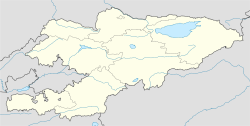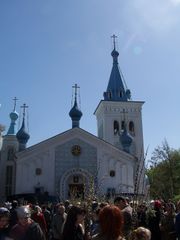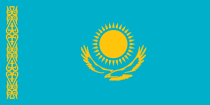Bishkek
| Bishkek Бишкек |
|||
|---|---|---|---|
| — City — | |||
| Kyrgyz transcription(s) | |||
| - ISO 9 | biškek | ||
| - BGN/PCGN | bishkek | ||
| - ALA-LC | bishkek | ||
 |
|||
|
|||
 Bishkek
|
|||
| Coordinates: | |||
| Country | |||
| Shaar | Bishkek[1] (It is, however, the capital of the Chuy Province) | ||
| Raion[2] |
Districts
Leninskiy District
Oktyabrskiy District Pervomayskiy District Sverdlovskiy District |
||
| Government | |||
| - Mayor | Isa Omurkulov | ||
| Area[3] | |||
| - Total | 127 km2 (49 sq mi) | ||
| Elevation | 800 m (2,625 ft) | ||
| Population (1999)[3] | |||
| - Total | 762,308 | ||
| - Estimate (2007) | 1,250,000 | ||
| - Density | 6,002.4/km2 (15,557.3/sq mi) | ||
| Time zone | UTC+6 (UTC+6) | ||
| Area code(s) | 312 | ||
| Bishkek | ||||||||||||||||||||||||||||||||||||||||||||||||||||||||||||
|---|---|---|---|---|---|---|---|---|---|---|---|---|---|---|---|---|---|---|---|---|---|---|---|---|---|---|---|---|---|---|---|---|---|---|---|---|---|---|---|---|---|---|---|---|---|---|---|---|---|---|---|---|---|---|---|---|---|---|---|---|
| Climate chart () | ||||||||||||||||||||||||||||||||||||||||||||||||||||||||||||
|
||||||||||||||||||||||||||||||||||||||||||||||||||||||||||||
|
||||||||||||||||||||||||||||||||||||||||||||||||||||||||||||
Bishkek (in Kyrgyz and Russian: Бишкек), formerly Pishpek and Frunze, is the capital and the largest city of Kyrgyzstan. Bishkek is also the administrative centre of Chuy Province which surrounds the city, even though the city itself is not part of the province but rather a province-level unit of Kyrgyzstan.
The name is thought to derive from a Kyrgyz word for a churn used to make fermented mare's milk (kumis), the Kyrgyz national drink. Founded in 1825 as the Kyrgyz-Khokand fortress of "Bishkek", then, in 1862, named as the Russian fortress Pishpek (крепость Пишпек)[4], in 1926 the city was renamed Frunze (Фрунзе), after the Bolshevik military leader Mikhail Frunze. In 1991, the Kyrgyz parliament restored the city's historical name.
Bishkek is situated at about 800 metres (2,600 ft) altitude just off the northern fringe of the Kyrgyz Ala-Too range, an extension of the Tian Shan mountain range, which rises up to 4,855 metres (15,928 ft) and provides a spectacular backdrop to the city. North of the city, a fertile and gently undulating steppe extends far north into neighboring Kazakhstan. The Chui River drains most of the area. Bishkek is connected to the Turkestan-Siberia Railway by a spur line.
Bishkek is a city of wide boulevards and marble-faced public buildings combined with numerous Soviet-style apartment blocks surrounding interior courtyards and, especially outside the city centre, thousands of smaller privately built houses. It is laid out on a grid pattern, with most streets flanked on both sides by narrow irrigation channels that water the innumerable trees which provide shade in the hot summers.
Contents |
History
Originally a caravan rest stop (possibly founded by the Sogdians) on one of the branches of the Silk Road through the Tian Shan range, the location was fortified in 1825 by the Uzbek khan of Kokhand with a mud fort.
The Kyrgyz legend says that the place was a burial site of the hero Bishkek, the local Kyrgyz war lord who fought for the Kyrgyz independence in the 18th century.
In 1862, the fort was conquered and razed when Tsarist Russia annexed the area. The site became a Russian garrison and was redeveloped and named "Pishpek" from 1877 onward by the Russian government, which encouraged the settlement of Russian peasants by giving them fertile black soil farms to develop. In 1926, the city became the capital of the newly established Kirghiz ASSR and was renamed "Frunze" after Mikhail Frunze, Lenin's close associate who was born in Bishkek and played key roles during the 1905 and 1917 revolutions and during the Russian civil war of the early 1920s.
The early 1990s were tumultuous. In June 1990, a state of emergency was declared following severe riots in southern Kyrgyzstan which threatened to spread to the capital. The city was renamed Bishkek on 5 February 1991 and Kyrgyzstan achieved independence later that year during the breakup of the Soviet Union. Before independence, Bishkek was a "Russified" city, the majority of its population being ethnic Russians. In 2004, Russians made up approximately 20% of the city's population.[5]
Today, Bishkek is a rapidly modernizing city, with many restaurants and cafes and lots of second-hand European and Japanese cars and minibuses crowding its streets. At the same time Bishkek still preserves its former Soviet feel, with Soviet-period buildings and gardens prevailing over newer structures.
Bishkek is also the country's financial centre, with all of the country's 21 commercial banks featuring offices in the city. During the Soviet era, the city was home to a large number of industrial plants, but most have been shut down or operate today on a much reduced scale. One of today's Bishkek's largest employment centres is Dordoy Bazaar, which is one the major entrepôts for Chinese goods imported into CIS countries.
In 2002, the United States obtained the right to use the nearby Manas International Airport as an air base for its military operations in Afghanistan and Iraq. Russia subsequently (2003) established an air base of its own (Kant Air Base) near Kant some 20 kilometres (12 mi) east of Bishkek. It is based at a facility that used to be home to a major Soviet military pilot training school; one of its students, Hosni Mubarak, later became president of Egypt.
Geography
Orientation
Though the city is relatively young, the surrounding area has some sites of interest dating from prehistory, the Greco-Buddhist period, the period of Nestorian influence, the era of the Central Asian khanates, and the Soviet period.



The central part of the city is primarily built on a rectangular grid plan. The city's main street is the east-west Chui Avenue (Prospekt Chui), named after the region's main river. In the Soviet era, it was called Lenin Avenue. Along, or within a block or two from it, many of the most important government buildings, universities, the Academy of Sciences compound, etc., are to be found. The westernmost section of the avenue is known as Deng Xiaoping Avenue.
The main north-south axis is Yusup Abdrakhmanov Street, still (2007) commonly referred to by its old name, Sovietskaya Street. Its northern and southern sections are called, respectively, Yelebesov and Baityk Batyr Streets. Several major shopping centres are located along it, and in the north it provides access to Dordoy Bazaar.
Erkindik ("Freedom") Boulevard runs north-south, from the main railroad station (Bishkek II) south of Chui Avenue to the museum quarter and sculpture park just north of Chui Avenue, and further north toward the Ministry of Foreign Affairs. In the past, it was called Dzerzhinsky Boulevard—named after Communist revolutionary, Felix Dzerzhinsky—and its northern continuation is still called Dzerzhinsky Street.
An important east-west street is Jibek Jolu ('Silk Road'). It runs parallel to Chui Avenue about a mile north of it, and is part of the main east-west road of Chui Province. Both the Eastern and Western bus terminals are located along Jibek Jolu.
City centre
- State Historical Museum, located in Ala-Too Square, the main city square
- State Museum of Applied Arts, containing examples of Kyrgyz traditional handicrafts
- Frunze House Museum
- Statue of Ivan Panfilov stands in the park near the White House.
- An equestrian statue of Mikhail Frunze still stands in a large park (Boulevard Erkindik) across from the train station.
- The train station itself was built in 1946 by German prisoners of war and has survived since then without further renovation or repairs; most of those who built it perished and were buried in unmarked pits near the station.
- The main government building, the White House, is a huge, seven story marble block and the former headquarters of the Communist Party of the Kirghiz SSR
- At Ala-Too Square, there is an Independence monument where the changing of the guards may be watched.
- Osh bazaar, west of the downtown area, is a large, picturesque produce market
Outer neighbourhoods
The Dordoy Bazaar, just inside the bypass highway on the north-eastern edge of the city, is a major retail and wholesale market.
Outside the city
The Kyrgyz Ala-Too mountain range, some 40 kilometres (25 mi) away, provides a spectacular backdrop to the city; the Ala Archa National Park is only a 30–45 minute drive away.
Climate
Bishkek has a humid continental climate (Köppen climate classification Dfa) averaging 322 clear days annually due to its mountainous location. Average precipitation is 380 millimetres (15 in) per year. Average daily temperatures range from −3 °C (26.6 °F) in January to about 24.7 °C (76.5 °F) during July.[6] The summer months are dominated by dry periods experiencing the occasional thunderstorm which produces strong gusty winds and rare dust storms. The mountains to the south provide a natural boundary to provide protection from much of the damaging weather along with the smaller chain which runs NW to SE. In the winter months, sparse snow storms and frequent heavy fog are the dominating features. When an inversion sets up, the fog can last for days at a time.
| Climate data for Bishkek | |||||||||||||
|---|---|---|---|---|---|---|---|---|---|---|---|---|---|
| Month | Jan | Feb | Mar | Apr | May | Jun | Jul | Aug | Sep | Oct | Nov | Dec | Year |
| Source: [6][7][8] | |||||||||||||
Ecology and Environment
Air Quality
Emissions of air pollutants in Bishkek amounted to 21.9 thousand tons in 2008 [9]. Of all other cities of Kyrgyzstan, the level of air pollution in Bishkek is the highest with occasional exceeding maximum allowable concentrations by several times, especially in the city's center.[10].
Responsibility for ambient air quality monitoring in Bishkek lies on Kyrgyz State Agency on Hydrometeorology. In total, there are 7 air quality monitoring stations in Bishkek, measuring levels of sulfur dioxide, nitrogen oxides, formaldehyde, and ammonia.[9]
Economy

Bishkek uses the Kyrgystan currency, the som. The som's value fluctuates regularly, but averages around 43 som per U.S. Dollar as of September 2009. The economy in Bishkek is primarily agricultural with the mass amounts of fruits, vegetables and livestock providing a co-existing system of bartering in the outlying regions. The streets of Bishkek are regularly lined with produce vendors in a market style venue. In the major portions of downtown there is a more urban cityscape with banks, stores, markets and malls. The most sought after of the goods are the prevalent hand-crafted artisan pieces; these include statues, carvings, paintings and many nature based sculptures.
Government
Local government is administered by the Bishkek Mayor's Office. Askarbek Salymbekov was mayor until his resignation in August 2005, following which his deputy Arstanbek Nogoev took over the mayorship. Nogoev was in turn removed from his position in October 2007 through a decree of President Kurmanbek Bakiyev and replaced by businessman and former first deputy prime minister Daniar Usenov.[11][12][13] In July 2008 former head of the Kyrgyz Railways Nariman Tuleyev was appointed mayor, who was unscrupulously displaced by the interim government after 7 April 2010. Now interim mayor is Isa Omurkulov, also former head of the Kyrgyz Railways.[14]
Sports
The city is home to the Bandy Federation of Kyrgyzstan[15] which is a member of the IOC recognized[16] Federation of International Bandy. It plans to send a team to the Asian Winter Games 2011.
Education
Educational institutions in Bishkek include:
Transportation



Mass public transport
There is public transportation available, including buses, electric trolley buses, and public vans (known in Russian as marshrutka). Taxi cabs can be found throughout the city.
There is no subway in Bishkek, but the city is considering designing and building a light rail system (Бишкекское лёгкое метро).
Commuter and long-distance buses
There are two main bus stations in Bishkek. The smaller old Eastern Bus Station is primarily the terminal for minibuses to various destinations within or just beyond the eastern suburbs, such as Kant, Tokmok, Kemin, Issyk Ata, or the Korday border crossing.
Long-distance regular bus and minibus services to all parts of the country, as well as to Almaty (the largest city in neighboring Kazakhstan) and Kashgar, China, run mostly from the newer grand Western Bus Station; only a smaller minority of them runs from the Eastern Station.
The Dordoy Bazaar on the north-eastern outskirts of the city also contains makeshift terminals for frequent minibuses to suburban towns in all directions (from Sokuluk in the west to Tokmak in the east) and to some buses taking traders to Kazakhstan and Siberia.
Rail
As of 2007, the Bishkek railway station sees only a few trains a day. It offers a popular three-day train service from Bishkek to Moscow.
There are also long-distance trains that leave for Siberia (Novosibirsk and Novokuznetsk), via Almaty, over the Turksib route, and to Yekaterinburg (Sverdlovsk) in the Urals, via Astana. These services are remarkably slow (over 48 hours to Yekaterinburg), due to long stops at the border and the indirect route (the trains first have to go west for more than a 100 kilometres (62 mi) before they enter the main Turksib line and can continue to the east or north). E.g., as of the fall of 2008, train No. 305 Bishkek-Yekaterinburg was scheduled to take 11 hours to reach the Shu junction—a distance of some 269 kilometres (167 mi) by rail, and less than half of that by road.[23]
Air
The city is served by Manas International Airport (IATA code FRU), located approximately 25 kilometres (16 mi) northwest of the city centre, and readily reachable by taxi.
Twinned cities
Sister cities of Bishkek include:
 Almaty, Kazakhstan
Almaty, Kazakhstan Astana, Kazakhstan
Astana, Kazakhstan Colorado Springs, Colorado, USA, since 1994
Colorado Springs, Colorado, USA, since 1994 Meriden, Connecticut, USA, since 2005
Meriden, Connecticut, USA, since 2005 Ankara, Turkey
Ankara, Turkey İzmir, Turkey
İzmir, Turkey Toronto, Canada, since 2008
Toronto, Canada, since 2008 Ürümqi, People's Republic of China
Ürümqi, People's Republic of China Minsk, Belarus, since 2008
Minsk, Belarus, since 2008
References
- ↑ Law on the Status of Bishkek, 16 April 1994, article 2 (Russian). Retrieved on 3 August 2009
- ↑ Districts of Bishkek (Russian). Retrieved on 3 August 2009
- ↑ 3.0 3.1 Statoids
- ↑ 282 Гвардейский Краснознаменный мотострелковый полк имени М. В. Фрунзе в/ч 73809 п/о Подгорное Кой-Таш [1]
- ↑ Residential Real Estate Market in Bishkek, Kyrgyzstan: Current Conditions and Prospects
- ↑ 6.0 6.1 "КЛИМАТ БИШКЕКА" (in Russian). Pogoda. http://pogoda.ru.net/climate/38353.htm. Retrieved 2010-06-10.
- ↑ "World Weather Information Service - Bishkek". World Meteorological Organisation (United Nations). http://worldweather.wmo.int/177/c00210.htm. Retrieved 2010-06-10.
- ↑ "Climatological Normals of Bishkek". Hong Kong Observatory. http://www.hko.gov.hk/wxinfo/climat/world/eng/asia/westasia/bishkek_e.htm. Retrieved 2010-06-10.
- ↑ 9.0 9.1 http://www.meteo.ktnet.kg/unzps/unzps.php Kyrgyz State Agency on Hydrometeorology (in Russian)
- ↑ http://www.nature.kg/index.php?option=com_content&view=article&id=18&Itemid=11&lang=ru Web-site of the State Agency on Environment Protection and Forestry: Assessment of Air Pollution
- ↑ "New mayor of Bishkek promises to solve capital’s problems". The Times of Central Asia. 17 October 2007. http://www.timesca.com/index.php?option=com_content&task=view&id=182916&Itemid=7. Retrieved 18 October 2007.
- ↑ Marat, Erica (15 October 2007). "Upcoming referendum sinks Kyrgyzstan deeper into crisis" (– Scholar search). Eurasia Daily Monitor (The Jamestown Foundation) 4 (190). http://jamestown.org/edm/article.php?article_id=2372503. Retrieved 18 October 2007.
- ↑ "Kyrgyz capital gets new mayor". Radio Free Europe. 22 August 2005. http://www.hri.org/news/balkans/rferl/2005/05-08-22.rferl.html#20. Retrieved 18 October 2007.
- ↑ "New Mayor for Bishkek". Lenta.Ru. 7 July 2008. http://www.lenta.ru/news/2008/07/07/bishkek/. Retrieved 25 September 2008.
- ↑ http://www.internationalbandy.com/viewNavMenu.do?menuID=59
- ↑ http://www.internationalbandy.com/viewNavMenu.do?menuID=4
- ↑ International University Of Kyrgyzstan
- ↑ International Ataturk-Alatoo University
- ↑ Kyrgyz National University
- ↑ Arabaev Kyrgyz State University
- ↑ Kyrgyz Russian Slavonic University
- ↑ Kyrgyz-Turkish MANAS University
- ↑ Schedule for train No. 305, Bishkek-Yekaterinburg (Russian)
External links
- Bishkek travel guide from Wikitravel
- The Spektator – Society, culture and travel articles on Kyrgyzstan as well as a guide to Bishkek
|
|||||||||||||||||||||||||||||


